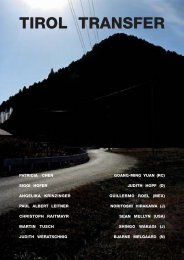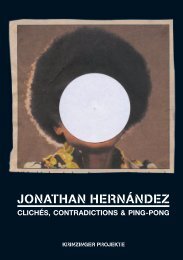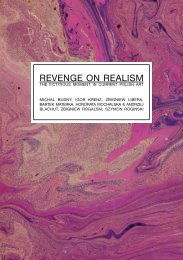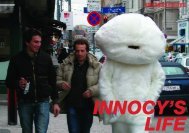post_modellismus – models in art - krinzinger projekte - Galerie ...
post_modellismus – models in art - krinzinger projekte - Galerie ...
post_modellismus – models in art - krinzinger projekte - Galerie ...
Create successful ePaper yourself
Turn your PDF publications into a flip-book with our unique Google optimized e-Paper software.
this ‘reality’ as an effect that is first and<br />
foremost geared to assert and establish<br />
an ‘analogy relationship’ between image<br />
and reality. The ‘medial effect’, however,<br />
applies equally to the reality <strong>in</strong> the picture<br />
and the picture. The photographic<br />
image thus becomes a mimicry of itself,<br />
s<strong>in</strong>ce it only pretends to be an image of<br />
reality even though it is not one <strong>in</strong> actual<br />
fact. The type of construction and reconstruction<br />
with<strong>in</strong> the image rema<strong>in</strong>s<br />
always visible <strong>in</strong> the picture - both <strong>in</strong> the<br />
model and <strong>in</strong> the photographic image.<br />
This way the <strong>art</strong>ist is able to construct<br />
various social, aesthetic, cultural as well<br />
as medial levels of mean<strong>in</strong>g which, <strong>in</strong> a<br />
number of respects, are of a prototypical<br />
nature. These are the positions of a<br />
prototypical gaze <strong>–</strong> even when Edw<strong>in</strong><br />
Zwakman’s images are less prospective<br />
than retrospective prototypes. Edw<strong>in</strong><br />
Zwakman establishes correspondences<br />
<strong>in</strong> and between the images which do<br />
justice to the idea of positions and perspectives<br />
be<strong>in</strong>g transformed <strong>in</strong> response<br />
to different <strong>–</strong> sociological, psychological<br />
and cultural historical <strong>–</strong> orders. The<br />
authority of the photographic image to<br />
make a clear statement on what can be<br />
seen <strong>in</strong> the picture is thus noticeably<br />
curtailed. The shot <strong>in</strong> question thus designates<br />
the correspond<strong>in</strong>g perspective,<br />
not just the relativity of photographic<br />
positions which are assumed to exist<br />
before and beh<strong>in</strong>d the camera by means<br />
of targeted <strong>in</strong>terventions. By contrast, <strong>in</strong><br />
the case of Edw<strong>in</strong> Zwakman’s works<br />
they open up a whole range of different<br />
<strong>in</strong>terpretations <strong>–</strong> from the media character<br />
of photography to the visibility of the<br />
photographic image. With<strong>in</strong> this scope<br />
this ‘suspicion’ is activated which, as<br />
Boris Groys elaborates, creates ‘its own<br />
reality <strong>–</strong> and, accord<strong>in</strong>gly, also its own<br />
criteria of truth’. 10<br />
This <strong>in</strong>tr<strong>in</strong>sic but also omnipresent reality<br />
and authority of the photographic image<br />
becomes p<strong>art</strong>icularly relevant with<strong>in</strong> Oliver<br />
Boberg’s image-def<strong>in</strong><strong>in</strong>g process. S<strong>in</strong>ce<br />
we are first of all deal<strong>in</strong>g with a photographic<br />
image, we tend to believe that<br />
what we have before us is the depiction<br />
of actually exist<strong>in</strong>g architecture. The<br />
common model used to expla<strong>in</strong> photography<br />
<strong>–</strong> one which suggests be<strong>in</strong>g able<br />
to transcend the image with regard to<br />
the depicted object <strong>–</strong> seems to allude to<br />
this possibility. That this strategy proves<br />
successful has to do with the fact that<br />
this reality <strong>in</strong> the image strikes us as<br />
be<strong>in</strong>g all too familiar, that is, the general<br />
idea we have of this type of architecture<br />
allows someth<strong>in</strong>g to be recognized. Oliver<br />
Boberg actually presents us a ‘median<br />
value’ of this architecture. 11 These many<br />
different photographic <strong>models</strong> yield<br />
sketches, and often, after many months<br />
of work, the <strong>art</strong>ist produces a detailed<br />
processed model. F<strong>in</strong>ally the photographic<br />
image of a place that never really<br />
existed emerges. Model and image are<br />
not modeled after a concrete location.<br />
The semblance of the familiar and banal<br />
thus proves to be a strategy which <strong>in</strong><br />
Boberg’s works does not just refer to a<br />
motif but also to the technique <strong>–</strong> for<br />
<strong>in</strong>stance with regard to the familiarity of<br />
an understand<strong>in</strong>g of the picture. Thus, <strong>in</strong><br />
his pictures the <strong>art</strong>ist deliberately applies<br />
the criteria of documentary photography<br />
that aims at neutrality and objectivity. He<br />
also takes recourse ‘to the standardized<br />
style of archival photography and to our<br />
personal experience.’ 12 All three aspects<br />
come to bear to the same extent, creat<strong>in</strong>g<br />
systems of reference that make people<br />
13









